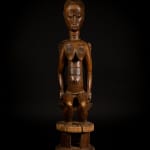Baule Figure of a Woman and Child, 19th - 20th century
Wood
height 101 cm
height 39 3/4 in
height 39 3/4 in
MA.226
Further images
Since the first publication of several Baule sculptures in Carl Einstein's seminal book Negerplastik in 1915, Baule art has been integral to Western African art appreciation. The Baule style is...
Since the first publication of several Baule sculptures in Carl Einstein's seminal book Negerplastik in 1915, Baule art has been integral to Western African art appreciation. The Baule style is perceived as one of the canonic African art traditions and its art historical significance is rivalled only by few other cultures, such as: Fang (Gabon), Senufo (Ivory Coast), Kongo (Western DRC) and Luba/Hemba (Eastern DRC).
This sculpture depicts a female figure sitting powerfully on a stool, with a child clinging to her back. The elongated torso of the female figure, with arms resting at the side of right-angled legs, strong calves denoting strength, protruding breasts, geometric scarification patterns and the downward-facing expression incarnate a physical and moral ideal within Baule society.
Susan M. Vogel ( Baule: African Art Western Eyes, New Haven and London, 1997, p. 61) notes: "While the relative naturalism and consummate workmanship of Baule objects were praised at the outset, today these objects are appreciated for their subtle rhythms and a beauty that stops short of sweetness. To the Western eye, an essence of Baule style is a balanced asymmetry that enlivens while suggesting stability and calm. [...] To an art historian, the most consistent feature of Baule art, and one expressed across the wide variety of Baule object types, is a kind of peaceful containment. Faces tend to have downcast eyes and figures often hold their arms against the body, so that Westerners might feel that the mood of much classical Baule art is introspective."
The Baule distinguish the visible from the invisible world, blolo (other world), inhabited by spirits. Prior to birth every human had a spouse and children who remain in the other world until being reunited upon death. This maternity figure is in all likelihood a representation of a spirit spouse and child in the other world, blolo.
Vogel (1997: 67) explains: "So far as people know, the other world resembles this world, and blolo spirits live in villages complete with elders and families, very much like those on earth. The concept of blolo includes a sense of vagueness and distance; the word itself contains this connotation. The blolo is not associated with any particular direction: it is neither above nor below the earth, nor is it where the dead are buried, though after their sojourn in this world they return there. The blolo is also the source of human life, the place from whence comes each newborn baby. Everyone originally came from the blolo and is never entirely free from relations with the spirits left behind there. Everyone had in the blolo an entire family that can continue to interfere with life after birth. Most often, however, it is the spouse in the other world who causes problems, and a Baule man or woman often has a figure carved to represent and appease his blolo bla, or spirit wife, or blolo bian, spirit husband."
This sculpture depicts a female figure sitting powerfully on a stool, with a child clinging to her back. The elongated torso of the female figure, with arms resting at the side of right-angled legs, strong calves denoting strength, protruding breasts, geometric scarification patterns and the downward-facing expression incarnate a physical and moral ideal within Baule society.
Susan M. Vogel ( Baule: African Art Western Eyes, New Haven and London, 1997, p. 61) notes: "While the relative naturalism and consummate workmanship of Baule objects were praised at the outset, today these objects are appreciated for their subtle rhythms and a beauty that stops short of sweetness. To the Western eye, an essence of Baule style is a balanced asymmetry that enlivens while suggesting stability and calm. [...] To an art historian, the most consistent feature of Baule art, and one expressed across the wide variety of Baule object types, is a kind of peaceful containment. Faces tend to have downcast eyes and figures often hold their arms against the body, so that Westerners might feel that the mood of much classical Baule art is introspective."
The Baule distinguish the visible from the invisible world, blolo (other world), inhabited by spirits. Prior to birth every human had a spouse and children who remain in the other world until being reunited upon death. This maternity figure is in all likelihood a representation of a spirit spouse and child in the other world, blolo.
Vogel (1997: 67) explains: "So far as people know, the other world resembles this world, and blolo spirits live in villages complete with elders and families, very much like those on earth. The concept of blolo includes a sense of vagueness and distance; the word itself contains this connotation. The blolo is not associated with any particular direction: it is neither above nor below the earth, nor is it where the dead are buried, though after their sojourn in this world they return there. The blolo is also the source of human life, the place from whence comes each newborn baby. Everyone originally came from the blolo and is never entirely free from relations with the spirits left behind there. Everyone had in the blolo an entire family that can continue to interfere with life after birth. Most often, however, it is the spouse in the other world who causes problems, and a Baule man or woman often has a figure carved to represent and appease his blolo bla, or spirit wife, or blolo bian, spirit husband."













